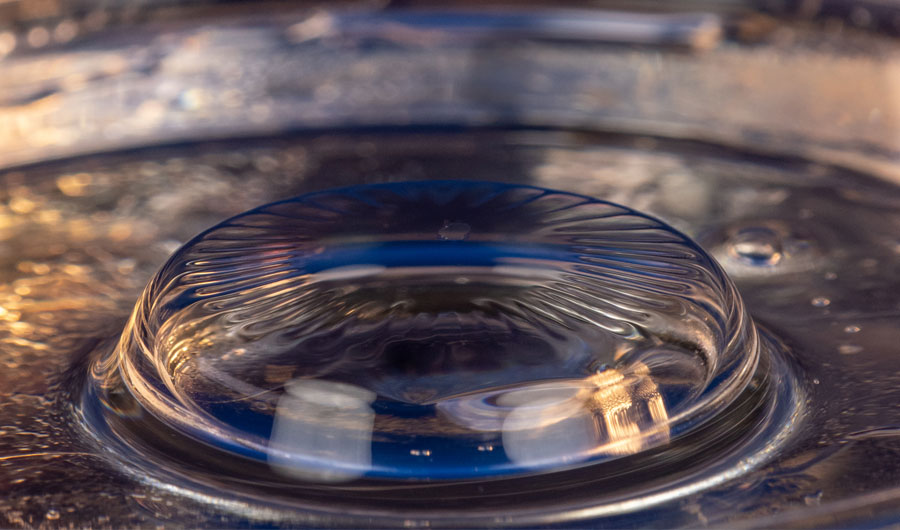New Theory Says We’ve Been Wrong About How Bubbles Pop

A viscous bubble collapsing under the force of surface tension.
Oliver McRae
(Inside Science) -- What do a volcanologist, a pulmonologist, and a glassmaker have in common? They all worry about bubbles. The physics of how bubbles form, behave and pop is crucial to understanding natural phenomena as well as many industrial processes. According to a new study appearing in the journal Science, scientists have been getting that physics wrong for at least a couple of decades.
The new findings suggest that instead of being driven by gravity, the collapse of bubbles that form on the surface of thick liquids is driven by surface tension, in a complex, unintuitive way. And to find the truth, all the researchers had to do was turn their experiment upside down.
The physics of a bubble depends on how thick -- viscous -- its fluid is. If a bubble floating on the surface of water is poked and popped, surface tension makes the bubble retract quickly and violently, vanishing in about a millisecond. But in a very viscous liquid, a surface bubble may take up to one full second to collapse. This gives researchers extra time to observe a complex interplay between forces that is perfect for studying the fundamental physics at work in bubble collapse.
When a hole is poked in the top of a surface bubble in a viscous liquid, that hole takes some time to grow larger. In that time, the bubble sinks, shrinking, until it is a flat disk with the hole in the middle. Intuitively, scientists concluded that gravity was the driving force behind the collapse, since the hole wasn’t growing as fast as the bubble was falling.
Caption: A viscous bubble with sufficiently large viscosity will collapse under the force of surface tension and adopt a wrinkling pattern along its periphery.
Credit: Alexandros Oratis and James Bird, Boston University
This explanation “didn’t quite sit right” with James Bird, an engineer at Boston University. Why was gravity only important for viscous bubbles? He decided to redo the original experiments that led to the gravity-driven conclusion -- with a twist.
He and his collaborators used the same material used in the original experiments: silicone oil, a liquid 1 million times more viscous than water. This fluid is so thick, they could flip a small container of the fluid upside down without the fluid flowing out. Once it was upside down, they popped a bubble on its surface.
They found that it collapsed in the exact same way a right-side-up bubble would: The hole at the top opened slowly, while the rest of the bubble dropped and flattened relatively quickly into a disk. But it “dropped” back toward the fluid, which was now in the opposite direction of gravity’s pull.
When the right-side-up experiment was done more than 20 years ago, “it was not unreasonable to assume that gravity is indeed driving this collapse, because the bubble looks like it’s just moving downward as it collapses,” said Alexandros Oratis, also an engineer at Boston University and paper co-author. “However, if you calculate the forces acting on the film, you find that the surface tension is actually much greater than gravity. So that’s what led to turning the experiment upside down, to test how much gravity was actually doing.”
Surface tension is a force that works to minimize the area of a surface. The surface area of a bubble’s hemispherical curve is greater than the area of the disk underneath it, and the force of the surface tension is only held at bay by the pressure inside the bubble is higher than outside it. Once a hole is made, the pressures equalize, and there is no longer any force maintaining the bubble’s curve; surface tension, seeking to minimize the surface area, forcefully contracts the bubble until it is flat.
But the surface tension doesn’t affect the entire bubble equally. The top of the bubble is far thinner than its walls near the base. This causes the bubble’s top to collapse faster than the walls cave in, mimicking the expected effect from gravity’s straight-down forces.
“It’s a new perspective on an old problem that people thought had been understood, showing that there's some important things that were not quite right about it,” said Dominic Vella, an applied mathematician at the University of Oxford in the U.K. “It’s a very nice piece of work.”
When a viscous bubble bursts, wrinkles appear around the bottom edge of the bubble. Intuitively, surface tension would prevent wrinkles from happening, as it tries to force a surface to be flat and straight. Previous work explained these wrinkles by saying that the force of gravity collapsing the bubble was strong enough to overcome the surface tension, creating wrinkles.
“We're saying that surface tension is the force causing this collapse,” said Bird. “And at the same time, the surface tension is preventing those wrinkles from happening. How we justify this paradox is that in thinner parts of the film, at the top of the bubble, surface tension can prevent wrinkles. In the thicker part at the bottom, the compression of the collapse is strong enough to overcome that surface tension and create wrinkles.”
“It shows how viscous liquids can obtain these elasticlike behaviors when compressed very, very rapidly,” Oratis added. “So it’s a nice analogy between elastic solids and viscous liquids, a visually beautiful example.”
In 2000, Rava da Silveira was a physics graduate student at MIT, where he co-authored one of the papers that concluded gravity was the most important factor in bubble collapse. Now he’s a computational neuroscientist at the Ecole Normale Supérieure, in Paris, France, and he said he admires this new study’s experimental design.
“What I like about this work is that they redo the same experiment under many conditions,” he said. “They do a bigger range of experimental variations. It’s quite a beautiful article.”

